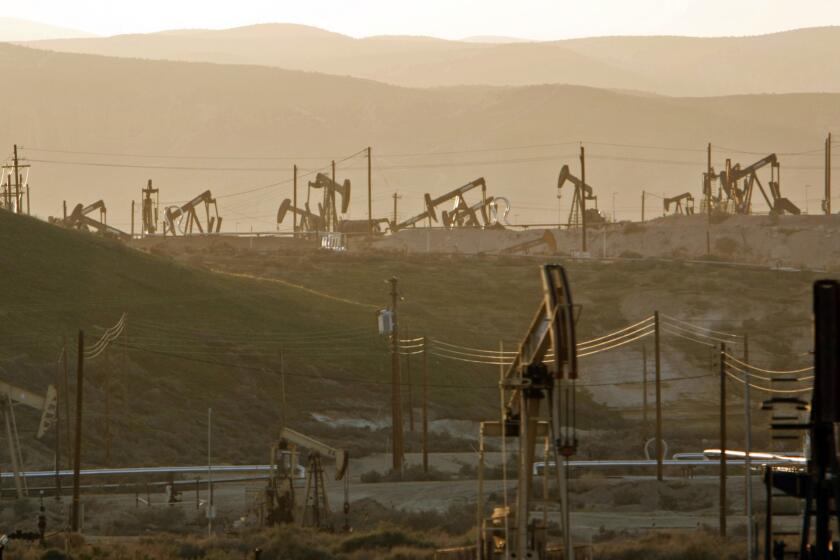First oil prices went negative. Now the shale oil industry is going to shut down

- Share via
Negative oil prices, ships dawdling off California ports with unwanted cargoes, and traders getting creative about where to stash oil. The next chapter in the oil crisis is now inevitable: large sections of the petroleum industry are about to start shutting down.
The economic impact of the coronavirus outbreak has ripped through the oil industry in dramatic phases. First it destroyed demand as stay-home restrictions shut factories and kept drivers at home. Then storage started filling up and traders resorted to ocean-going tankers to store crude in the hope of better prices ahead.
Now shipping prices are surging to stratospheric levels as the industry runs out of tankers — a sign of just how distorted the market has become.
The specter of production shutdowns — and the impact they will have on jobs, companies, their banks and local economies — was one of the reasons that spurred world leaders to join forces to cut production in an orderly way. But as the scale of the crisis dwarfed their efforts, failing to stop prices diving below zero last week, shutdowns are now a reality. It’s the worst-case scenario for producers and refiners.
“We are moving into the end game,” Torbjorn Tornqvist, head of commodity trading giant Gunvor Group Ltd., said in an interview. “Early-to-mid May could be the peak. We are weeks, not months, away from it.”
In a 20-minute span that ranks among the most extraordinary in the history of financial markets, the price of oil cratered to a level that few, if any, thought conceivable.
In theory, the first oil output cuts should have come from the OPEC+ alliance, which earlier this month agreed to reduce production from May 1. Yet after the catastrophic price plunge Monday, when West Texas Intermediate fell to negative $40 a barrel, it’s the U.S. shale patch that is leading.
The best indicator of how the U.S. industry is reacting is the rapid drop in the number of oil rigs in operation, which last week fell to a four-year low. Before the coronavirus crisis hit, oil companies ran about 650 rigs in the U.S. By Friday, more than 40% of them had stopped working, with only 378 left.
“Monday really focused people’s minds that production needs to slow down,” Ben Luckock, co-head of oil trading at commodity merchant Trafigura Group, said. “It’s the smack in the face the market needed to realize this is serious.”
Trafigura, one of the largest exporters of U.S. crude from the U.S. Gulf of Mexico, believes that output in Texas, New Mexico, North Dakota and other states will now fall much faster than expected as companies react to negative prices, which have persisted for several days last week in the physical market.
Until prices collapsed Monday, the consensus was that output would drop by about 1.5 million barrels a day by December. Now market watchers see that loss by late June. “The severity of the price pressure is likely to act as a catalyst for the immediate turndown in activity and shut-ins” or closing off wells, said Roger Diwan, oil analyst at consultant IHS Markit Ltd.
Oil futures dived below zero for the first time ever amid the coronavirus-triggered economic turmoil.
The price shock has been particularly intense in the physical market: Producers of crude streams such as South Texas Sour and Eastern Kansas Common had to pay more than $50 a barrel to offload their output last week. ConocoPhillips and shale producer Continental Resources Inc. have announced plans to shut in output. Regulators in Oklahoma voted to allow oil drillers to shut wells without losing leases; New Mexico made a similar decision.
North Dakota, which for years was synonymous with the U.S. shale revolution, is witnessing a rapid retrenchment. Oil producers have already closed more than 6,000 wells, curtailing about 405,000 barrels a day in production, or about 30% of the state’s total.
The output cuts won’t be limited to the U.S. From Chad, a poor and landlocked country in Africa, to Vietnam and Brazil, producers are now either reducing output or making plans to do so.
“I wouldn’t want to get sensational about it but yes, clearly there must be a risk of shut ins,” Mitch Flegg, the head of North Sea oil company Serica Energy, said in an interview. “In certain parts of the world it is a real and present risk.”
In emergency board meetings last week, oil companies small and large discussed an outlook that’s the most somber any oil executive has ever witnessed. For the small firms, the next few weeks will be all about staying afloat. But even for the bigger ones, like Exxon Mobil Corp. and BP Plc, it’s a challenge. Big Oil will offer an insight into the crisis when companies report earnings this week.
Saudi Arabia, Russia and the rest of the OPEC+ alliance will join the output cuts Friday, slashing their output by more than 20%, or 9.7 million barrels a day. Saudi Aramco, the state-owned company, is already trimming to reach the target. And Russian oil companies have announced exports of their flagship Urals crude would drop in May to a 10-year low.
Stunning video shows dozens of oil tankers off L.A. coast with nowhere to go
Even so, it may not be enough. Every week, 50 million barrels of crude are going into storage, enough to fuel Germany, France, Italy, Spain and the U.K. combined. At that rate, the world will run out of storage by June. What’s not stored onshore is stashed in tankers. The U.S. Coast Guard on Friday said there were so many tankers at anchor off California that it was keeping an eye on the situation.
Before the crisis hit, the world was consuming about 100 million barrels a day. Demand now, however, is 65 million to 70 million barrels. So, in a worst-case scenario, about a third of global output needs to be shut.
The reality is likely to be less severe as storage would continue to bridge the gap between supply and demand. Plus, oil traders say consumption has probably hit a bottom, and will start a very gentle recovery.
Oil futures sank by 31% in a matter of seconds after the open of trading Monday in Asia, the worst decline since the Gulf War in 1991.
But before that takes hold, the great shutdown will spread through oil refining too.
Over the last week, Marathon Petroleum Corp., one of the biggest U.S. refiners, announced it would stop production at a plant near San Francisco. Royal Dutch Shell Plc has idled several units in three U.S. refineries in Alabama and Louisiana. And across Europe and Asia, many refineries are running at half rate. U.S. oil refiners processed just 12.45 million barrels a day on the week to April 17, the lowest amount in at least 30 years, except for hurricane-related closures.
More refinery shutdowns are coming, oil traders and consultants said, particularly in the U.S. where stay-home orders started later than in Europe and demand is still contracting. Steve Sawyer, director of refining at Facts Global Energy, said that global refineries could halt as much as 25% of total capacity in May.
“No one is going to be able to dodge this bullet,” he said.
More to Read
Inside the business of entertainment
The Wide Shot brings you news, analysis and insights on everything from streaming wars to production — and what it all means for the future.
You may occasionally receive promotional content from the Los Angeles Times.













